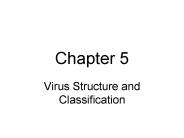Virus, its types, classification and replication of virus - PowerPoint PPT Presentation
Title:
Virus, its types, classification and replication of virus
Description:
Virus, its types, classification and replication of virus – PowerPoint PPT presentation
Number of Views:388
Title: Virus, its types, classification and replication of virus
1
Virus, its types, classification and replication
of virus
2
Overview
3
Virus
- Definition
- an infective agent that typically consists of a
nucleic acid molecule in a protein coat, is too
small to be seen by light microscopy, and is able
to multiply only within the living cells of a
host.
4
Virus
- Size Comparison
- Cant be seen by eye or light micro-scope
5
Virus
- Size Comparison
- Their effects can be observed
- Cytopathic effects
- Enlarged nuclei in tissues
6
Structure
- Genome or coreDNA or RNA
- Capsid protects genome
- Also have virally encoded proteins that help in
replication - Some virus have envelopes on outer Virion surface
that interact with surface of cell
7
(No Transcript)
8
(No Transcript)
9
Viral Genomes
- RNA or DNA SS or DS (strands) linear or
circular - Used to classify viruses
- DNA viruses replicate in host nucleus, share a
common patterns as host cells - RNA viruses must have specific enzymes that are
not in cells so can make RNA for new viruses - Viral and Cellular proteins are not similar
- Virus encodes enzymes and proteins that modify
the cells in which virus replicate
10
Viral capsids
- Complex
- Many identical subunits of viral proteins
- 1 subunit 1 capsomer
- Protects viral genome in 2 stable shapes for a
particle of nucleic acid and protein-
nucleoprotein - Helix --capsomer associates with helical genome
- Icosahedron regular, solid shape that enfolds
viral genome
11
Capsids have symmetry
- Capsids around genome is unique for each type of
virus - They have symmetry which is criteria for
classification - Capsid structure is defined by X-ray
Crystallography - Capsids have various complexity of structures
based on viral genomes
12
(No Transcript)
13
Viral membrane envelopes
- Some viruses have a lipid envelope that surrounds
the capsid - Lipid bilayer is from the cell in which the virus
has previously replicated - This virally encoded proteins are also used to
characterize the viruses - Usually is amorphous because shape is defined by
the capsid
14
Classification
- International Committee on Taxonomy of Viruses
15
Classification scheme
- Based on basic properties of virus and specific
features of replication cycle - What type of genome
- RNA/DNA, SS/DS, linear/circular
- How is capsid arranged
- Symmetry and dimension
- What other components?
- Envelope
- Proteins in virion responsible for infection
16
Baltimore Scheme
- Used mainly for RNA viruses and based on how mRNA
is synthesized - Limited by type of genome
- Sense RNA virusRNA serves as mRNA template
- - Sense RNA virusRNA serves as complimentary
sense of mRNA - Retrovirus-- Sense RNA but use DNA in
replication cycle
17
Baltimore Classification System
- Class 1 Double-stranded DNA viruses
- Class 2 Single-stranded DNA viruses
- Class 3 Double-stranded RNA viruses
- Classes 4 5 Single-stranded RNA viruses
- Class 4 Single-stranded RNA viruses -
positive-sense - Class 5 Single-stranded RNA viruses -
negative-sense - Class 6 Positive-sense single-stranded RNA
viruses that replicate through a DNA intermediate - Class 7 Double-stranded DNA viruses that
replicate through a single-stranded RNA
intermediate
18
Taxonomy
19
(No Transcript)
20
(No Transcript)
21
Replication
- The virus replication occurs in seven stages,
namely - Adsorption,
- Entry
- Uncoating
- Transcription / mRNA production
- Synthesis of virus components
- Virion assembly
- Release (Liberation Stage)
22
Replication
23
Replication
- Lysogenic cycle
- Lytic cycle
24
Replication
25
(No Transcript)































